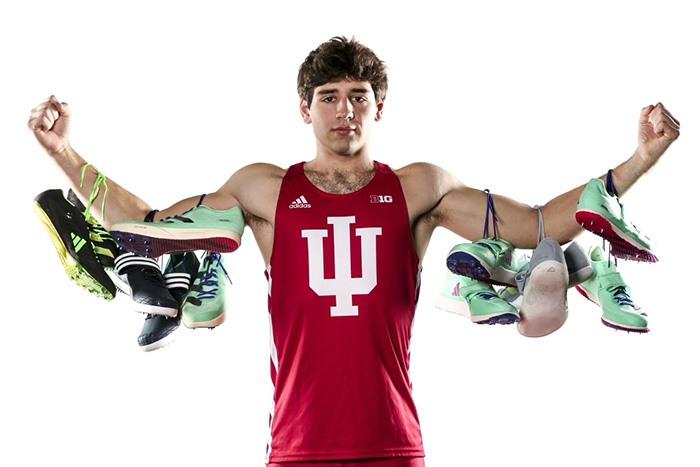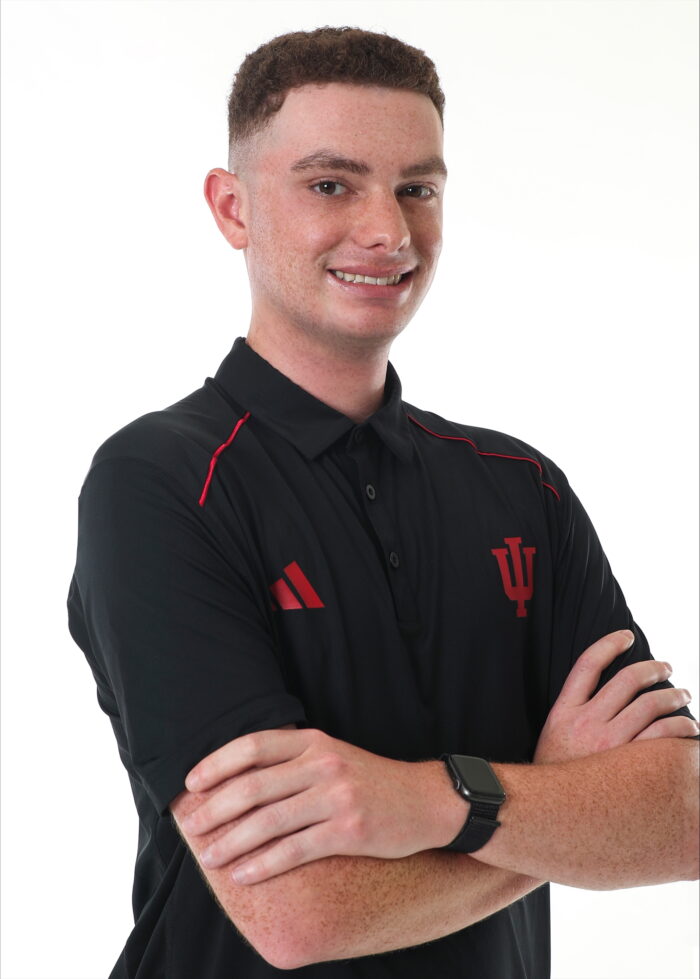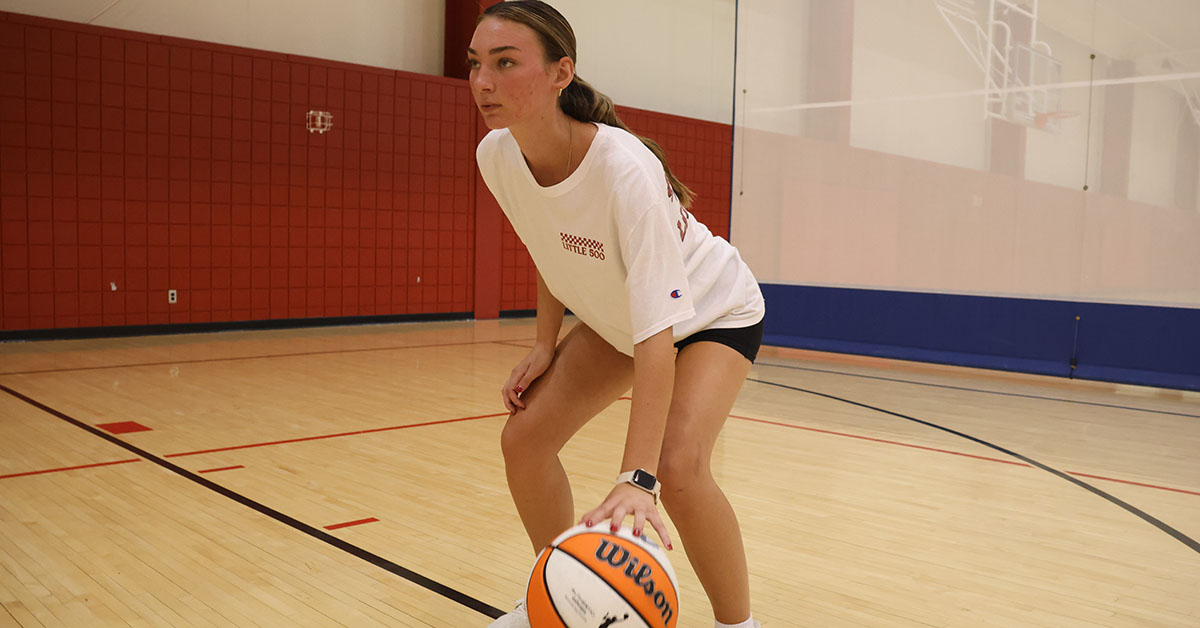Aisling Zarate

Hi I am Aisling Zarate and I am from New Carlisle, Indiana and I'm currently a freshman at Indiana University Bloomington. I am majoring in media with a concentration of media advertising.
By AnaCecilia Cornejo, Aisling Zarate, and Sonny Hoekstra,
BLOOMINGTON, Ind. (Oct. 30, 2024) – Eyes focused, heart racing, a weighted metal ball in hand, patiently awaiting the announcement to throw. The track team can be heard from across the sidelines, screaming and radiating energy for their team. Drew Franklin can feel his muscles tense up as the time is ticking, quickly planting his feet to get his proper foot positioning. Transferring all his energy from his legs to his core, he slings the ball forward and it lands. The judge quickly goes over to measure the distance, now all that awaits is the results.

The results are in and Franklin has successfully set a new record in his Shot Put event! The whole crowd and team erupted in cheer as they stood to give a standing ovation. After the meet Franklin takes to social media to share his accomplishments with his followers. Like many athletes, Drew Franklin, a current sophomore at Indiana University Bloomington, has seen how the role of social media corresponds with Name, Image, and Likeness deals.
NIL, short for “Name, Image, and Likeness,” grants college and high school athletes the right to profit from their own image. NIL rights allow athletes to engage in endorsement deals, advertising, merchandise sales, and paid social media sponsorships. Previously, there has been a lot of controversy surrounding the NCAA, which prohibited student-athletes from monetizing their NIL deals. But that has since changed following the 2021 U.S. Supreme Court ruling. In 2024, the NCAA reached a settlement that further expands NIL rights, allowing colleges to compensate their athletes and allocating nearly $2.8 billion for past and current athletes. Athletes can now leverage from NIL rights by signing contracts and working with brands.
Since NIL has been established, athletes like Franklin have been able to explore the territory of NIL with social media and leverage financially. This has changed the game completely. With many social media sites, such as TikTok, increasing in popularity IU athletes have been taking advantage. “A lot of attention comes from TikTok” , said Franklin. He explained how companies look into your profile and audience. “Athletes on my team who have more followers and overall likes, are getting asked to do promotions more often”, said Franklin. This new era of athlete influencers has transformed social media with the utilization of social media as a professional asset to gain profit opportunities.

NIL has also been a great opportunity for brands to work with collegiate athletes. By using athletes, brands can expand their reach to various audiences. College sports are becoming more and more popular in recent years, so by using a popular athlete’s image there is an opportunity to reach a larger audience within a specific demographic. This allows brands to connect with consumers on a more personal level. Professor Joe Glennon at Indiana University has seen his fair share of brand building. Professor Glennon was the department chair of Advertising and Public Relations at Temple University and is now a senior lecturer for Indiana University’s Media School. “There’s a direct relationship between share of voice and market share. That’s on the consumer and brand side, but there’s a parallel to that on the athlete and NIL side”, said Glennon. The marketing metric, share of voice (SOV) Glennon mentions, measures how much a brand is being talked about compared to its competitors. The value and image of the brand is helped when having a relationship with athletes on social media, especially when the athletes image aligns with theirs.
Indiana University Athletics has demonstrated the importance of how real-time content in sports has affected the engagement of their social media posts as well as their athletes. Jack Venegoni, a current Indiana University Athletics Social / Digital Media Intern knows personally how IU’s efforts has boosted athlete visibility. Working with the Cuban Center for Sports Media Venegoni has worked with various teams such as football, men and women’s basketball, volleyball and many others. During basketball season, Venegoni would receive photos during the games and begin uploading them live during the game. “The athletes are able to use all photos and videos we take of them on their personal counts”, Venegoni said. Player highlights being posted online in real time boosts their personal brand, fans from all over the country interact as the emotions are at an all time high.

Venegoni also noted about an NIL deal that became a huge deal in Bloomington, the Malik Reneau burger. After his freshman year, Indiana University’s basketball power forward Malik Reneau signed a NIL Deals with Big Woods restaurant to get his own item on the menu. The burger has been advertised all over Reneau’s social media and brought a lot of publicity to Big Woods. The restaurant has gained a lot of social media attention because of this and “It became a big deal and became a meme, it soon got more people to realize that they haven’t even tried it and gave them more publicity”, said Venegoni. Through partnerships like this, athletes and business both mutually benefit and drive significant business growth. Social media is important within NIL deals because the influence and fanbase from a collegiate athlete can create buzz and attract new customers for business and brands.
The relationship between social media and NIL deals has benefitted athletes, brands, and business. As seen through athletes like Drew Franklin and Malik Reneau, the use of social media has increased their reach, turning their athletic accomplishments into a valuable resource for themselves and partnering with businesses. Online presence allows for brands to interact with college sports audiences while providing athletes with opportunities to take advantage of their likeness. NIL deals are more than just partnerships with brands, athletes and brands now work together to build connections and relationships that are shared online.
Indiana University students share their opinion on how social media effects college athletes. Many college athletes have taken to social media to build themselves a personal brand.
Featured photo taken by Lauren Bacho.
###
Media Contacts
Alex Drago (writer)
Aisling Zarate (photographer)
Isabella Trine (editor)
CUPERTINO, California (Sept. 9, 2014) – On Tuesday, Tim Cook, CEO of Apple, unveiled the newest addition to the Apple family, the Apple Watch. This smart-watch allows you to use many of the iPhone features from the convenience of your wrist.
Towards the end of the event, just when the unknowing audience thought it was over, Cook surprised his audience when he presented Apple’s new product, the Apple Watch. “But we’re not quite finished yet. We have one more thing,” Cook said. The audience cheered loudly, unaware that there was going to be more. Cook expressed how this new tech watch has been in the works for a very long time and that this product would redefine what people expect from technology. As Cook walked off the stage, the lights went dim, and the big screen revealed the innovative smartwatch.


Beaming with pride, Cook came back out on stage and displayed the Apple Watch on his wrist. This high-tech product is incredibly customizable and personal. “You can find one that reflects your personal style and taste. Because you wear it, we invented new, intimate ways to connect and communicate directly from your wrist,” Cook said. Some of its features include a health and fitness companion, being able to receive phone calls, and answer emails.
While the Apple Watch is similar to the iPhone, it is also diverse in that Apple placed extra functionality on the watch, such as the dial on the top right side of the watch, known as the digital crown, and translates motor movement into data. This is used in place of ‘pinching and zooming’ on an iPhone. The digital crown allows users to scroll on text messages and other apps, and return to the home screen by pressing on it. The crowd cheered loudly as they found this feature fascinating. In order to have an Apple Watch, you need to have it connected to an iPhone, and the watch includes a feature where users can see music played on the devices around and the watch can control music on iPhone, Apple computer, and the music stored at the watch.
Jony Ive, Senior Vice President of Design at Apple, went on to thoroughly describe features of the watch in a video. I’ve described how when creating the watch, they wanted to take a powerful piece of technology and make it accessible, relevant, and personable. They designed this product to be so personable that you would not want it to get into the wrong person’s hands, so consumers wear it on their wrists. Apple wanted users to embrace the individuality that came from wearing the watch. The new Apple watch is so personable to the user that when the user raises their wrist, it senses the movement and activates the home screen which consists of a variety of apps that are familiar to iPhone users.
As the video directed by Ive goes on, it displays all the different features the Apple Watch contains. These include making phone calls, creating timers, a library of music, the calendar, weather, and many more. “Apps are designed for lightweight interaction,” Ive said. The watch creates a way for users to have an easily accessible feature you would have on the iPhone, but from right on your person which can be worn everyday, for any occasion. As the video ended, the audience embraced it with applause for so long and loud that Cook could barely get a word out. Cook’s face showed all his emotions, and he waved to the audience as he was elated to see how positively the audience reacted.
Apple’s team had worked on the Apple Watch for a long time. They covered every aspect needed to create this very unique piece of technology. Cook called out one of the key contributors to the device, Kevin Lynch, the Vice President of Apple, to give the first live demo of the watch. Lynch came out wearing the watch on his left wrist, for the audience to see the demo, Lynch had a custom watch connected to the screen. He goes on to explain features such as the face of the watch, which is extremely customizable as you can change the font, color, and functionality. “…We’ve also been working to enable third-party developers to extend their apps to Apple Watch,” Lynch said. Lynch then goes on to explain how users can use social media apps like Facebook, Twitter, and Pinterest. “It’s something functional yet incredibly beautiful, it empowers people and enriches their lives,” Cook said. This watch is motivated to help people to be active, and healthy, and have an easily accessible piece of technology. Apple’s newest addition will be available in stores on April 24, 2015. “It will be available early next year and it is worth the wait,” Cook said.
Co-founder and CEO of Apple, Steve Jobs, shown above sharing that the Apple Watch shares many of the iPhones innovative features. Apple focused on bringing the technology of their iPhones and Macs down to a much smaller size.
Kevin Lynch, Vice President of Apple, seen above demonstrating the features of the maps app on the Apple Watch. He is showing that many of the iPhone’s capabilities can also be used on the Apple Watch.
###